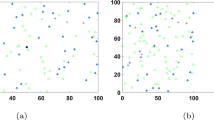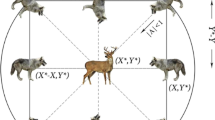Abstract
In wireless sensor networks (WSNs), balancing energy consumption is always a critical problem. Multi-hop data transmission may cause the nodes around the static sink to exhaust energy prematurely. It can be avoided by introducing the mobile sink (MS) in WSNs. The MS only needs to visit some specific nodes, such as cluster heads (CHs) in the clustering network, to collect data. In this paper, we propose an energy-adaptive clustering method based on Taguchi-based-GWO optimizer (EACM-TGWO). Different from the existing clustering protocols, we develop the optimal number of CHs according to the characteristic of energy consumption in MS-based WSNs. Afterwards, the fitness function is established by combining the residual energy and the average distance within clusters to select CHs. Meanwhile, an adaptive weight factor is introduced to dynamically tune the influence degree of the two factors on the clustering results. Furthermore, a novel meta-heuristic algorithm Taguchi-based grey wolf optimizer (TGWO) is used to search for the optimal CHs set. Compared with grey wolf optimizer (GWO) and some of its improved versions, TGWO is more excellent tested in CEC2017. We also make an elaborate comparison of EACM-TGWO with LEACH-C, EACM-GWO, MSECA, and GAOC. The simulation results indicate that EACM-TGWO is more powerful in terms of balancing energy consumption and saving network energy.











Similar content being viewed by others
Data availability
My document has no associated data.
References
Di Francesco M, Das SK, Anastasi G (2011) Data collection in wireless sensor networks with mobile elements: a survey. ACM Trans. Sensor Netw. (TOSN) 8(1):1–31. https://doi.org/10.1145/1993042.1993049
Li J, Li G-C, Chu S-C, Gao M, Pan J-S (2022) Modified parallel tunicate swarm algorithm and application in 3d WSNS coverage optimization. J Int Technol 23(2):227–244
Khan AW, Abdullah AH, Anisi MH, Bangash JI (2014) A comprehensive study of data collection schemes using mobile sinks in wireless sensor networks. Sensors 14(2):2510–2548. https://doi.org/10.3390/s140202510
Li J, Han Q, Wang W (2022) Characteristics analysis and suppression strategy of energy hole in wireless sensor networks. Ad Hoc Netw 135:102938. https://doi.org/10.1016/j.adhoc.2022.102938
Zhu C, Han G, Zhang H (2017) A honeycomb structure based data gathering scheme with a mobile sink for wireless sensor networks. Peer-to-Peer Netw Appl 10(3):484–499. https://doi.org/10.1007/s12083-016-0496-6
Mehto A, Tapaswi S, Pattanaik K (2020) A review on rendezvous based data acquisition methods in wireless sensor networks with mobile sink. Wirel Netw 26(4):2639–2663. https://doi.org/10.1007/s11276-019-02022-6
Mehto A, Tapaswi S, Pattanaik K (2021) Optimal rendezvous points selection to reliably acquire data from wireless sensor networks using mobile sink. Computing 103(4):707–733. https://doi.org/10.1007/s00607-021-00917-x
Han Y, Li G, Xu R, Su J, Li J, Wen G (2020) Clustering the wireless sensor networks: a meta-heuristic approach. IEEE Access 8:214551–214564. https://doi.org/10.1109/ACCESS.2020.3041118
Khan MI, Gansterer WN, Haring G (2013) Static vs mobile sink: the influence of basic parameters on energy efficiency in wireless sensor networks. Comput Commun 36(9):965–978. https://doi.org/10.1016/j.comcom.2012.10.010
Li J, Gao M, Pan J-S, Chu S-C (2021) A parallel compact cat swarm optimization and its application in dv-hop node localization for wireless sensor network. Wirel Netw 27(3):2081–2101. https://doi.org/10.1007/s11276-021-02563-9
Krishnan M, Yun S, Jung YM (2019) Dynamic clustering approach with ACO-based mobile sink for data collection in WSNS. Wirel Netw 25(8):4859–4871. https://doi.org/10.1007/s11276-018-1762-8
Lipare A, Edla DR, Kuppili V (2019) Energy efficient load balancing approach for avoiding energy hole problem in WSN using grey wolf optimizer with novel fitness function. Appl Soft Comput 84:105706. https://doi.org/10.1016/j.asoc.2019.105706
Verma S, Sood N, Sharma AK (2019) Genetic algorithm-based optimized cluster head selection for single and multiple data sinks in heterogeneous wireless sensor network. Appl Soft Comput 85:105788. https://doi.org/10.1016/j.asoc.2019.105788
Chauhan V, Soni S (2020) Mobile sink-based energy efficient cluster head selection strategy for wireless sensor networks. J Ambient Intell Humaniz Comput 11(11):4453–4466. https://doi.org/10.1007/s12652-019-01509-6
Pitchaimanickam B, Murugaboopathi G (2020) A hybrid firefly algorithm with particle swarm optimization for energy efficient optimal cluster head selection in wireless sensor networks. Neural Comput Appl 32(12):7709–7723. https://doi.org/10.1007/s00521-019-04441-0
Gupta GP, Saha B (2020) Load balanced clustering scheme using hybrid metaheuristic technique for mobile sink based wireless sensor networks. J Ambient Intell Human Comput. https://doi.org/10.1007/s12652-020-01909-z
Sahoo BM, Amgoth T, Pandey HM (2020) Particle swarm optimization based energy efficient clustering and sink mobility in heterogeneous wireless sensor network. Ad Hoc Netw 106:102237. https://doi.org/10.1016/j.adhoc.2020.102237
Wei Q, Bai K, Zhou L, Hu Z, Jin Y, Li J (2021) A cluster-based energy optimization algorithm in wireless sensor networks with mobile sink. Sensors 21(7):2523. https://doi.org/10.3390/s21072523
Kathiroli P, Selvadurai K (2021) Energy efficient cluster head selection using improved sparrow search algorithm in wireless sensor networks. J King Saud Univ Comput Inf Sci. https://doi.org/10.1016/j.jksuci.2021.08.031
Heinzelman WR, Chandrakasan A, Balakrishnan H (2000) Energy-efficient communication protocol for wireless microsensor networks. Proc 33rd Ann Hawaii Int Conf Syst Sci. https://doi.org/10.1109/HICSS.2000.926982
Heinzelman WB, Chandrakasan AP, Balakrishnan H (2002) An application-specific protocol architecture for wireless microsensor networks. IEEE Trans Wirel Commun 1(4):660–670. https://doi.org/10.1109/TWC.2002.804190
Chu S-C, Tsai P-W, Pan J-S (2006) Cat swarm optimization. Pacific Rim Int Conf Artif Intell. https://doi.org/10.1007/978-3-540-36668-3_94
Poli R, Kennedy J, Blackwell T (2007) Particle swarm optimization. Swarm Intell 1(1):33–57. https://doi.org/10.1007/s11721-007-0002-0
Pan J-S, Tsai P-W, Liao Y-B (2010) Fish migration optimization based on the fishy biology. In: 2010 Fourth International Conference on Genetic and Evolutionary Computing, pp 783–786. https://doi.org/10.1109/ICGEC.2010.198
Pan J-S, Hu P, Chu S-C (2021) Binary fish migration optimization for solving unit commitment. Energy 226:120329. https://doi.org/10.1016/j.energy.2021.120329
Song P-C, Chu S-C, Pan J-S, Yang H (2020) Phasmatodea population evolution algorithm and its application in length-changeable incremental extreme learning machine. In: 2020 2nd International Conference on Industrial Artificial Intelligence (IAI), pp 1–5. https://doi.org/10.1109/IAI50351.2020.9262236
Pan J-S, Song P-C, Chu S-C, Peng Y-J (2020) Improved compact cuckoo search algorithm applied to location of drone logistics hub. Mathematics 8(3):333. https://doi.org/10.3390/math8030333
Dorigo M, Birattari M, Stutzle T (2006) Ant colony optimization. IEEE Comput Intell Mag 1(4):28–39. https://doi.org/10.1109/MCI.2006.329691
Mirjalili S, Mirjalili SM, Lewis A (2014) Grey wolf optimizer. Adv Eng Softw 69:46–61. https://doi.org/10.1016/j.advengsoft.2013.12.007
Faris H, Aljarah I, Al-Betar MA, Mirjalili S (2018) Grey wolf optimizer: a review of recent variants and applications. Neural Comput Appl 30(2):413–435. https://doi.org/10.1007/s00521-017-3272-5
Mittal N, Singh U, Sohi BS (2016) Modified grey wolf optimizer for global engineering optimization. Appl Comput Intell Soft Comput. https://doi.org/10.1155/2016/7950348
Long W, Jiao J, Liang X, Tang M (2018) An exploration-enhanced grey wolf optimizer to solve high-dimensional numerical optimization. Eng Appl Artif Intell 68:63–80. https://doi.org/10.1016/j.engappai.2017.10.024
Wang YJ, Ma CL (2018) Opposition-based learning differential ion motion algorithm. J Inf Hiding Multimed Signal Process 9(4):987–996
Yu X, Xu W, Li C (2021) Opposition-based learning grey wolf optimizer for global optimization. Knowl-Based Syst 226:107139. https://doi.org/10.1016/j.knosys.2021.107139
Heidari AA, Pahlavani P (2017) An efficient modified grey wolf optimizer with lévy flight for optimization tasks. Appl Soft Comput 60:115–134. https://doi.org/10.1016/j.asoc.2017.06.044
Tsai P-W, Pan J-S, Chen S-M, Liao B-Y (2012) Enhanced parallel cat swarm optimization based on the Taguchi method. Expert Syst Appl 39(7):6309–6319. https://doi.org/10.1016/j.eswa.2011.11.117
Wang H, Geng Q, Qiao Z (2014) Parameter tuning of particle swarm optimization by using taguchi method and its application to motor design. In: 2014 4th IEEE International Conference on Information Science and Technology, pp 722–726. https://doi.org/10.1109/ICIST.2014.6920579
Zhan Z-H, Zhang J, Li Y, Shi Y-H (2010) Orthogonal learning particle swarm optimization. IEEE Trans Evol Comput 15(6):832–847. https://doi.org/10.1109/TEVC.2010.2052054
Gao W-F, Liu S-Y, Huang L-L (2013) A novel artificial bee colony algorithm based on modified search equation and orthogonal learning. IEEE Trans Cybern 43(3):1011–1024. https://doi.org/10.1109/TSMCB.2012.2222373
Li X, Wang J, Yin M (2014) Enhancing the performance of cuckoo search algorithm using orthogonal learning method. Neural Comput Appl 24(6):1233–1247. https://doi.org/10.1007/s00521-013-1354-6
Hu J, Chen H, Heidari AA, Wang M, Zhang X, Chen Y, Pan Z (2021) Orthogonal learning covariance matrix for defects of grey wolf optimizer: insights, balance, diversity, and feature selection. Knowl-Based Syst 213:106684. https://doi.org/10.1016/j.knosys.2020.106684
Li J, Li Y-X, Tian S-S, Zou J (2019) Dynamic cuckoo search algorithm based on Taguchi opposition-based search. Int J Bio-Insp Comput 13(1):59–69. https://doi.org/10.1504/IJBIC.2019.097728
Tsai J-T, Liu T-K, Chou J-H (2004) Hybrid Taguchi-genetic algorithm for global numerical optimization. IEEE Trans Evol Comput 8(4):365–377. https://doi.org/10.1109/TEVC.2004.826895
Feng Z-K, Liu S, Niu W-J, Li B-J, Wang W-C, Luo B, Miao S-M (2020) A modified sine cosine algorithm for accurate global optimization of numerical functions and multiple hydropower reservoirs operation. Knowl-Based Syst 208:106461. https://doi.org/10.1016/j.knosys.2020.106461
Author information
Authors and Affiliations
Corresponding author
Ethics declarations
Conflict of interest
The authors declare that they have no conflict of interest. No funding was received for conducting this study.
Additional information
Publisher's Note
Springer Nature remains neutral with regard to jurisdictional claims in published maps and institutional affiliations.
Rights and permissions
Springer Nature or its licensor (e.g. a society or other partner) holds exclusive rights to this article under a publishing agreement with the author(s) or other rightsholder(s); author self-archiving of the accepted manuscript version of this article is solely governed by the terms of such publishing agreement and applicable law.
About this article
Cite this article
Wang, Z., Chu, SC., Li, J. et al. An energy-adaptive clustering method based on Taguchi-based-GWO optimizer for wireless sensor networks with a mobile sink. Computing 105, 1769–1793 (2023). https://doi.org/10.1007/s00607-023-01168-8
Received:
Accepted:
Published:
Issue Date:
DOI: https://doi.org/10.1007/s00607-023-01168-8




